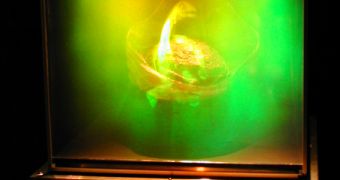In 1925, Albert Einstein predicted the existence of the atom laser, a completely different type of laser, but until now, no one could actually build one, so it was considered almost a practical impossibility. For the first time, a team of Italian scientists managed to create such a device.
The word Laser is an acronym for "light amplification by stimulated emission of radiation". Lasers are possible because of the way light interacts with electrons and the beam consists entirely of photons, released by electrons as excess energy, when they drop from an outer to an inner level.
Much like an optical laser, an atom laser is a coherent beam that behaves like a wave, but no one had managed to create a coherent beam of atoms instead of photons. Massimo Inguscio and colleagues at the Florence University, Italy, created the first functioning laser, more than eight decades after it had been theorized by Einstein.
So far, every attempt to build such a laser failed because of the same problem, the impossibility of stopping atoms from bouncing into one another, which prevented the formation of a coherent beam.
As Inguscio said, "an atomic laser is eagerly awaited in the field of micro-electronics" with many potential applications in various devices and sensors, like atom holography images, having a much higher resolution than conventional holographic images.
They achieved the much wanted coherence of the beam by using potassium isotopes to build an "atomic condensate" squeezed into a harmonious whole by a magnetic field, much like Einstein and Satyendra Nath Bose envisioned long ago, in what is now known as a Bose-Einstein condensate of atoms, a state of matter formed by a system of bosons confined in an external potential and cooled to temperatures very near to absolute zero (0 kelvin or −273.15 ?C).
"In this way the interaction of atoms is virtually nonexistent," Inguscio said, thus creating the world's first atom-only laser.

 14 DAY TRIAL //
14 DAY TRIAL //